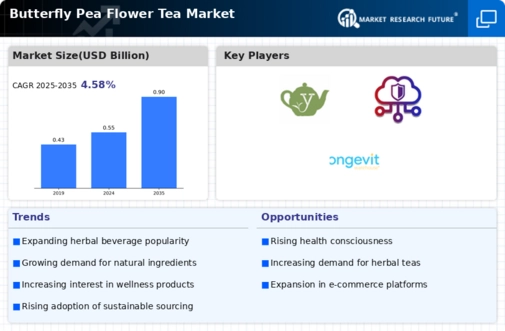Market Growth Projections
The Global Butterfly Pea Flower Tea Industry is poised for growth, with projections indicating a market size of 0.55 USD Billion in 2024 and an anticipated increase to 0.9 USD Billion by 2035. This growth trajectory suggests a compound annual growth rate (CAGR) of 4.62% from 2025 to 2035. Such figures reflect the increasing consumer interest in herbal teas and the expanding availability of butterfly pea flower tea products across various retail channels. The market's expansion is likely to be supported by ongoing trends in health consciousness, e-commerce growth, and innovative product offerings.
Rising Health Consciousness
The Global Butterfly Pea Flower Tea Industry experiences a surge in demand driven by increasing health consciousness among consumers. As individuals become more aware of the health benefits associated with herbal teas, the appeal of butterfly pea flower tea, known for its antioxidant properties and potential health benefits, grows. This trend is particularly evident in regions where consumers seek natural remedies and wellness products. The market is projected to reach 0.55 USD Billion in 2024, reflecting a growing preference for healthier beverage options. This shift towards health-oriented consumption patterns is likely to propel the industry's growth in the coming years.
Innovative Product Development
The Global Butterfly Pea Flower Tea Industry is characterized by innovative product development that caters to evolving consumer preferences. Manufacturers are increasingly experimenting with flavor combinations and packaging designs to attract a broader audience. For instance, the introduction of ready-to-drink butterfly pea flower tea beverages and blends with other herbal ingredients has gained traction. This innovation not only enhances the product's appeal but also aligns with the growing trend of convenience among consumers. As a result, the market is likely to experience a compound annual growth rate (CAGR) of 4.62% from 2025 to 2035, indicating a robust response to consumer demand for novel tea experiences.
Expansion of E-commerce Platforms
The Global Butterfly Pea Flower Tea Industry benefits from the rapid expansion of e-commerce platforms, which facilitate easier access to specialty teas. Online retailing allows consumers to explore a diverse range of butterfly pea flower tea products, including organic and flavored varieties, without geographical limitations. This trend is particularly significant in urban areas where consumers prefer the convenience of online shopping. The increasing penetration of internet services and mobile devices further supports this growth. As a result, the market is expected to witness substantial growth, with projections indicating a rise to 0.9 USD Billion by 2035, driven by the accessibility provided by e-commerce.
Sustainability and Organic Sourcing
The Global Butterfly Pea Flower Tea Industry is increasingly shaped by sustainability trends and the demand for organic products. Consumers are becoming more discerning about the sourcing of their food and beverages, favoring products that are sustainably harvested and free from synthetic additives. Butterfly pea flower tea, often marketed as organic, aligns well with these consumer preferences. The emphasis on environmentally friendly practices in cultivation and production is likely to enhance brand loyalty and attract environmentally conscious consumers. This trend is expected to contribute positively to the market's growth trajectory, as more brands adopt sustainable practices to meet consumer expectations.
Cultural Influence and Traditional Practices
The Global Butterfly Pea Flower Tea Industry is influenced by cultural practices and traditional uses of butterfly pea flower in various regions. In Southeast Asia, for example, this tea has been consumed for centuries for its purported health benefits and vibrant color. As global interest in diverse cultural practices increases, consumers are drawn to traditional beverages like butterfly pea flower tea. This cultural appreciation not only enhances the market's visibility but also encourages the incorporation of butterfly pea flower tea into modern culinary practices. Such cultural influences are likely to sustain the industry's growth as consumers seek authentic experiences in their beverage choices.















Leave a Comment